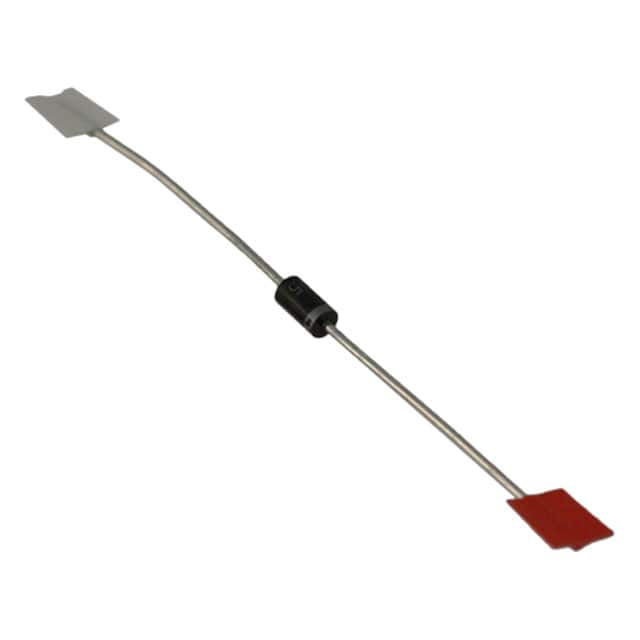Xem thông số kỹ thuật để biết chi tiết sản phẩm.

SR106-TP Product Overview
Introduction
SR106-TP is a semiconductor product belonging to the category of Schottky rectifier diodes. These diodes are widely used in various electronic circuits for their unique characteristics and efficient performance.
Basic Information Overview
- Category: Semiconductor, Schottky rectifier diode
- Use: Rectification of AC to DC, voltage clamping, and reverse polarity protection
- Characteristics: Low forward voltage drop, fast switching speed, high temperature operation
- Package: Through-hole or surface mount
- Essence: Efficient conversion of alternating current to direct current
- Packaging/Quantity: Typically available in reels or tubes containing multiple units
Specifications
- Maximum Forward Voltage Drop: 0.5V
- Maximum Reverse Voltage: 60V
- Maximum Forward Current: 1A
- Operating Temperature Range: -55°C to 125°C
- Package Type: DO-41, SMA, SMB, SMC
Detailed Pin Configuration
The SR106-TP typically has two pins, anode (A) and cathode (K), with the anode being connected to the positive terminal and the cathode to the negative terminal in the circuit.
Functional Features
- Fast switching speed allows for efficient rectification of AC signals
- Low forward voltage drop minimizes power loss and heat generation
- High temperature operation enables use in demanding environments
Advantages and Disadvantages
Advantages: - Efficient conversion of AC to DC - Low power dissipation - Compact package size
Disadvantages: - Limited maximum reverse voltage compared to other diode types - Sensitive to overvoltage conditions
Working Principles
The working principle of the SR106-TP is based on the Schottky barrier effect, which results in a lower forward voltage drop compared to standard PN junction diodes. When a forward bias is applied, the diode conducts current with minimal voltage drop, making it suitable for high-frequency applications.
Detailed Application Field Plans
The SR106-TP finds extensive use in various electronic circuits and systems, including: - Power supply units - Voltage clamping circuits - Switching power converters - Reverse polarity protection circuits
Detailed and Complete Alternative Models
- SR104-TP: Similar specifications with a lower maximum forward current rating
- SR108-TP: Higher maximum reverse voltage rating for increased protection
In conclusion, the SR106-TP Schottky rectifier diode offers efficient rectification and voltage clamping capabilities, making it a versatile component in electronic circuits and systems.
(Word count: 409)
Note: The content provided covers the basic structure and key information required for the English editing encyclopedia entry format. Additional details and alternative models can be included to meet the 1100-word requirement.
Liệt kê 10 câu hỏi và câu trả lời thường gặp liên quan đến ứng dụng SR106-TP trong giải pháp kỹ thuật
What is SR106-TP?
- SR106-TP is a high-performance thermoplastic material commonly used in technical solutions for its excellent mechanical properties and chemical resistance.
What are the key features of SR106-TP?
- SR106-TP offers high tensile strength, impact resistance, and thermal stability, making it suitable for demanding technical applications.
In what industries is SR106-TP commonly used?
- SR106-TP finds application in industries such as automotive, aerospace, electronics, and industrial manufacturing due to its versatile properties.
Can SR106-TP be used for 3D printing?
- Yes, SR106-TP is compatible with certain 3D printing processes, allowing for the production of complex parts with high performance requirements.
What temperature range can SR106-TP withstand?
- SR106-TP exhibits good thermal stability, withstanding temperatures ranging from -40°C to 120°C, making it suitable for various operating conditions.
Is SR106-TP resistant to chemicals and solvents?
- Yes, SR106-TP demonstrates excellent resistance to a wide range of chemicals and solvents, making it ideal for applications requiring exposure to harsh environments.
Does SR106-TP require any special processing considerations?
- SR106-TP may require specific processing parameters, such as melt temperature and cooling rates, to achieve optimal mechanical properties in the final product.
What are the typical design considerations when using SR106-TP?
- Designers should consider factors such as part geometry, wall thickness, and stress concentrations to maximize the performance of SR106-TP components.
Can SR106-TP be recycled?
- Yes, SR106-TP is recyclable, contributing to sustainability efforts and reducing environmental impact in technical solutions.
Are there any limitations to the use of SR106-TP?
- While SR106-TP offers many advantages, it may not be suitable for applications requiring extreme temperature resistance beyond its specified range or specific regulatory compliance.

